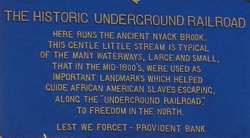 by John Patrick Schutz
by John Patrick Schutz
In February of 1879, a remarkable woman passed away here in Nyack. Cynthia Hesdra was born right here in Rockland in 1808 to John and Jane Moore of Tappan. Her father was well-known all over Rockland as the owner of the mill on the Sparkill Creek. As the inventor of an improvement to the mill wheel that was used all over the Hudson Valley, John Moore was also one of the wealthiest men in the area at the time. He was proud to have his mill producing blankets for the Union Soldiers fighting the Civil War.
It is frighteningly unclear how this freeborn young lady wound up enslaved but kidnappings of free African-Americans were not unknown at the time and despite her father’s notoriety and community support it appears her family was unable to liberate her from her bondage in the American South.
She would meet her husband during her period of slavery ‘€“ Edward Hesdra was the ‘€œmulatto’€ son of a white Jewish Virginia planter and a free black woman from Haiti. They would purchase her freedom and flee north, settling first in Greenwich Village where she began a laundry and a money lending business.
Through hard work and smart investment, Hesdra soon owned (in her own name, it appears that her hubby was not as industrious) her own home and a dozen other properties on MacDougall, Sullivan and Bleecker Streets. Having established the beginnings of her personal fortune, she moved herself and her husband to Nyack.
Here Hesdra would again establish another laundry business and another money-lending business while continuing to operate her businesses and manage her properties in Greenwich Village. Soon she would own additional properties in Nyack and nearby Bergen County along with her local and city businesses and properties. By the standards of the time, she was quite a wealthy self-made woman ‘€“ by today’s standards a multi-millionaire.
She and her husband were also quietly helping others still in bondage in the unrepentant South ‘€“ by opening their home as a station on the ‘€œFreedom Trail’€ ‘€“ the mysterious and legendary Underground Railroad. With the night sky’s constellations as their guide and the threat of torture or death behind, intrepid men and women slipped away from plantations and farms seeking the north and freedom meeting helpful ‘€station keepers’€ – both white and black – on their dangerous journey to freedom. (A new sculpture in the center of Frederick Douglass Circle at Central Park West and W.110th Street shows the constellation ‘€œmap’€ used by the fleeing slaves) Led there by the constellation map and the Nyack Brook, some of the fugitives would choose to stay in Nyack. Many would continue on to New York City with its large free-black community while others would run the tracks all the way to Canada.
At the time of her death in February 1879, Cynthia Hesdra had acquired quite a fortune and her death sparked a precedent setting and much publicized court battle by her heirs. Previously unknown Wills, additional falsified wills, unknown relatives and fraudulent heirs all marked a battle that played itself out in the Courtroom and in the Papers, until 1890 when it was finally all settled. The New York Times of June of 1890 would sum up the contentious probate battle in a series of stories called ‘€œFor An Ex-Slave’s Fortune.’€ The case would mark the first application of a new law in New York State that allowed for comparisons between known and disputed signatures.
The historically significant Hesdra House stood at the corner of Main Street and 9W but was torn down to build the utterly charming and well-utilized tan and brown building on the corner that formerly held a pet supply center and a rug store. You may sense my sarcasm here, and though even though as a real estate agent I am in favor of development, I consider the loss of a historic structure without a significant reason and well-researched development plan to be nothing short of sinful. We have so little left in the area that is significant historically, let alone significant to our long-term African-American community, I wish that there had been some responsible thought in maintaining a home that played a pivotal past role to so many people alive today.
Granted, there is a historical marker in place on the corner ‘€“ but in a final insult to a woman who went from freedom to enslavement to self-made real estate tycoon, the home is listed in her HUSBAND’s name on the marker, despite the fact house and the fortune resulted from HER industrious nature.
If you cross 9W from the marker and walk down the hill to the Provident Savings Bank, you can see one of the few places where the Nyack Brook is not culverted, but still open to the sky ‘€“ the same sky that led fleeing slaves to the Brook, where they would follow its’ banks to a safe haven in Cynthia Hesdra’s corner home. A local resident recently proposed that the brook property be acquired and a Village Park established with historical markers to explain the significance of the site, and benches to allow one to sit and appreciate an untouched part of Nyack’s original environment. I would like to heartily second that wonderful suggestion!
If you want to find out more about Cynthia Hesdra, read the ‘€œThe Ex-Slave’s Fortune,’€ by Nyack native Dr. Lori L. Martin, a dean at John Jay College in NYC.
John Patrick Schutz is a realtor for Rand Realty in Nyack, NY. You can read his blog posts at AtHomeInNyack.








